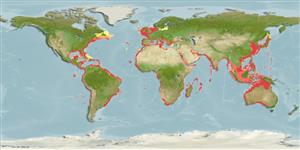Common names from other countries
Classification / Names / Names
俗名 | 同種異名 | Catalog of Fishes (gen., sp.) | ITIS | CoL | WoRMS
Environment: milieu / climate zone / depth range / distribution range
生態學
礁區魚類; 海洋洄游的 (Ref. 75927); 深度上下限 0 - 347 m (Ref. 417), usually 0 - 100 m (Ref. 1977). ? - 7°C (Ref. 275), preferred 26°C (Ref. 107945); 57°N - 38°S, 98°W - 146°E (Ref. 275)
分布
國家 | FAO區域 | 生態系 | 發現紀錄 | 簡介
Circumglobal in temperate and tropical seas.
Length at first maturity / 大小 / 重量 / 年齡
Maturity: Lm ?, range 8 - 11.3 cm Max length : 180 cm TL 雄魚/尚未辨別雌雄; (Ref. 104052); 120 cm TL (female); 最大體重: 10.0 kg (Ref. 275)
Maximum common depth is 150 m in Ref. 75927. Maximum depth range from Ref. 114857. Maximum length for female from Ref. 804. This octopus is taken by amateur fishers and in small to large-scale harvest throughout its range. The greatest fishery effort occurs off northwest Africa, and it is know as one of the most valuable octopod species throughout the Mediterranean Sea where it is marketed fresh or frozen (Ref. 96968).
Life cycle and mating behavior
成熟度 | 繁殖 | 產卵場 | 卵 | 孕卵數 | 仔魚
Members of the class Cephalopoda are gonochoric. Male and female adults usually die shortly after spawning and brooding, respectively. Mating behavior: Males perform various displays to attract potential females for copulation. During copulation, male grasp the female and inserts the hectocotylus into the female's mantle cavity where fertilization usually occurs. Life cycle: Embryos hatch into planktonic stage and live for some time before they grow larger and take up a benthic existence as adults.
主要參考資料
參考文獻 | 合作者 | 合作者
Roper, C.F.E., M.J. Sweeney and C.E. Nauen. 1984. (Ref. 275)
IUCN 瀕危狀態 (Ref. 130435: Version 2024-1)
無危 (LC) ; Date assessed: 08 April 2016
CITES狀態 (Ref. 108899)
Not Evaluated
Not Evaluated
人類使用
漁業: 商業性
FAO - 漁業: landings, 魚種描繪 | FIRMS (Stock assessments) | FishSource | 周邊海洋
工具
網路資源
Estimates based on models
Preferred temperature
(Ref.
115969): 10 - 28.9, mean 25.8 (based on 8514 cells).
回復力
高度, 族群倍增時間少於 15個月 (K=0.38-0.72; tm=1.2).
Prior r = 0.77, 95% CL = 0.51 - 1.15, Based on 4 full stock assessments.
瀕危性
Moderate to high vulnerability (48 of 100).
